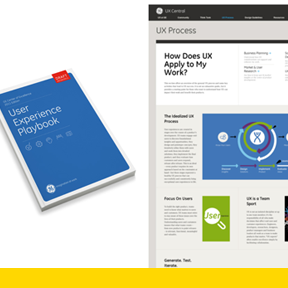1/1
GE User Experience Strategy and Capacity Building
Despite an executive mandate to build the user-experience capability, it is impossible to build momentum within GE without creating value directly with the individual businesses. This strategy developed in parallel with executing a series of pilot projects that apply user-experience thinking to high-profile software applications.
The project team worked with four businesses (transportation, energy, aviation and health-care) to introduce user-experience methods and improve the design of software applications that do everything from tracking aircraft engines through repair and maintenance to managing the performance of a fleet of energy plants to monitoring compliance in hospitals with hand-washing regulations. These hands-on design efforts provided a good understanding of the operating environment across a broad range of businesses and helped to identify user-experience practitioners and executives who saw the value of user-experience thinking for their businesses. These pilots provided an indispensable base of knowledge to understand how to build a broader user-experience strategy.
The pilots were supplemented with a survey of the software landscape, auditing 18 different applications from across the businesses to better understand the variety of contexts in which GE software was used. This uncovered a set of patterns regarding common user types across industries and common capabilities necessary to support business processes and add value. Consolidating this knowledge into a map of the software landscape revealed the value of design in identifying patterns and highlighting valuable areas for investment. Analyzing the different ways that software is packaged and sold within GE, often as part of long-term service and maintenance contracts in which software was either given away or provided incremental revenue at best, provided insight into potential business arguments for investing in user-experience thinking.
An audit of the organizational capability surrounding user-experience convened more than 50 design and product leads for a series of quarterly workshops to tackle topics like user-experience process, roles and business value frameworks. This was the first chance for many design practitioners, even within the same business, to meet and share their experiences. These sessions created a foundation of language, needs, roles, tools and success metrics that is the core of an emerging user-experience knowledge base, UX Central, an online digital hub for the entire organization. This led to a GE-branded user-experience process that pools the experience of these teams and aligns with GE’s famous Six Sigma process. The design team identified key metrics that can be used by the business to certify their approach to the user experience. These activities culminated in a two-day workshop that brought user experience, business and software leadership together to set a roadmap for user-experience investment priorities for 2012.
发布于2019-11-29
设计奖项
美国IDEA工业设计奖
Gold/金奖
2012 年
颜色

